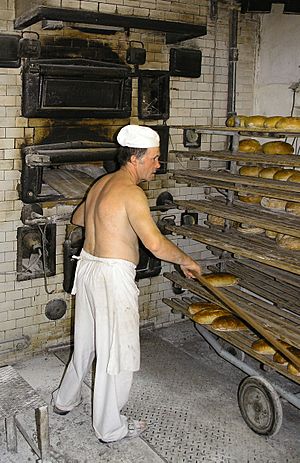Baker facts for kids

A baker is a person who makes delicious baked goods, mostly bread. Some bakers also create yummy cakes and desserts. The place where a baker works is called a bakery.
People have been baking for a very long time! The ancient Egyptians made the first bread around 8000 BC. In the Middle Ages, many towns had a public oven. People would bring their dough to the baker to be cooked.
Today, bread is often sweeter than it was long ago. This is because bakers now use ingredients like corn syrup or honey.
Contents
The History of Baking
Baking is a very old skill because grains have been a main food for thousands of years. But learning to control yeast to make bread rise is more recent.
Baking in Ancient Times
Around 500 to 600 years before Christ, the ancient Greeks used special ovens heated by wood fires. Often, everyone in a community would bake their bread in one big shared oven.
Later, in ancient Rome, baking became a real job. This is when many breads were made for the first time. Roman bakers used honey and oil to make pastries, which are like sweet breads. Sometimes, bakers in ancient Rome were slaves. They could sometimes earn their freedom.
The Gauls, an ancient people, found out something cool. Adding beer froth to bread dough made the bread rise really well! This was an early way to use controlled yeast in baking.
Baking in the Middle Ages
In medieval Europe, bakeries were often built away from other buildings. Sometimes they were even outside city walls. This was to stop fires from spreading, as ovens got very hot.
Bread was a super important food back then. So, rules were made about how bakers worked. For example, in 1267, King Henry III of England made a law called the Assize of Bread and Ale. This law set fees for bakers and brewers. It also made sure that bread was inspected for its quality and weight. Prices were also controlled.
After this law, baking became a very steady job. Towns usually had fewer bakers than brewers. Ovens were expensive and needed careful handling. So, special bakeries opened up just for baking.

The Surname "Baker"
The name Baker is a common English surname. It comes from the job of a baker in medieval times. Baxster was the female version of this name.
Many other languages have similar family names that mean "baker." For example:
- Boulanger or Fournier in French
- Pfister or Becker in German
- Piekarz in Polish
What Bakers Do and Their Risks
Bakers have many important tasks. The Bureau of Labor Statistics in the United States says bakers usually do these things:
- They check the quality of baking ingredients.
- They get their equipment ready for baking.
- They carefully measure and weigh flour and other ingredients.
- They mix ingredients together in large mixers.
- They knead, roll, cut, and shape the dough.
- They place the dough into pans or onto baking sheets.
- They set the right temperatures for ovens.
- They put items into ovens or onto grills.
- They watch the food as it bakes to make sure it looks perfect.
- They add glazes, icings, or other toppings.
Bakers make many kinds of breads, pastries, and other baked goods. These are sold in grocery stores, restaurants, and other food places. Some bakers even create brand new recipes!
Safety for Bakers
Bakers can face some dangers at work. Bakeries, especially big ones, have hot ovens, mixing machines, and dough cutters. Because of this, bakers can get hurt or sick more often than people in other jobs.
Common risks include:
- Back strains from lifting heavy bags of flour.
- Cuts and scrapes.
- Burns from hot ovens.
To stay safe, bakers often wear back supports, aprons, and gloves.
One health issue bakers can get is called Baker's asthma. This is often caused by allergens in flour. It can also be caused by tiny living things called enzymes used to help bread rise.
Bakers vs. Pastry Chefs
Both bakers and pastry chefs make delicious desserts and breads. In some places, one person might do both jobs. But in other places, there's a clear difference:
- Bakers usually focus on making breads, rolls, and muffins.
- Pastry chefs usually make desserts like cakes, pies, tarts, and cookies.
Even when both work in the same place, they might sometimes help each other with different tasks.
Images for kids
-
The Baker (c. 1681); oil-on-canvas painting by Job Adriaensz Berckheyde.
-
Bread of Eucharist in the Churches of the East (Prosphorus). This bread is leavened.
-
A rolling pin is used to work dough.
-
A bakery in Riyadh with traditional Afghan Bread (Tamees).
See also
 In Spanish: Panadero para niños
In Spanish: Panadero para niños









